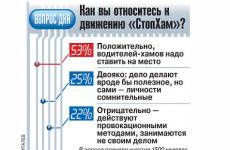Explanation of the topic converting expressions containing square roots. Using the properties of roots when transforming irrational expressions, examples, solutions. Vii. Writing a test
§ 1 Conversion of expressions containing the operation of extracting a square root
Let's recall the properties of square roots: if a, b are non-negative numbers a, b ≥ 0, then the following equalities are true:

Using these formulas, you can perform various transformations of expressions containing the operation of square root extraction, but with the condition that the variables of these expressions take only non-negative values. Having made this assumption, consider a few examples.
Example 1: Simplify the expression:
Since the expression contains a fraction, we will use the second property to transform it:
![]()
The third property was used to transform the denominator:
As a result, the initial expression takes the form:
Example 2: Subtract a factor from the square root sign:
![]()
When solving the example under the letter A, we will use the first and third properties of the square root:
Similarly, we transform the expression presented in the task under the letter B:
Example 3: Factor in the square root for
To factor in the root sign, we use the third property from right to left:
![]()
Let's solve several problems of transforming expressions containing the operation of extracting a square root, using the formulas of abbreviated multiplication. First, let's remember and write them out:
(a + b) 2 = a2 + 2ab + b2
(a - b) 2 = a2 - 2ab + b2
a2 - b2 = (a + b) (a - b)
a3 - b3 = (a-b) (a2 + ab + b2)
a3 + a3 = (a + b) (a2 - ab + b2)
Example 4: Simplify the expression:
To solve the problem, let's represent the number three as the square root of three squared:
and in the denominator we use the formula for the difference of squares, then we get:

Example 5: Simplify the expression:
![]()
To solve, first, consider the expression:
Assuming that
then ![]()
using the cubes sum formula
We get
Let's make the appropriate replacement.
Secondly, from the operation of division by (a - b), we turn to the operation of multiplication by the reciprocal:
Thirdly, we will reduce the first fraction in the parenthesis by the expression:
and then we will perform the multiplication operation.
Let's assume:
using the formula for the difference of squares, we get:
![]()
The expression in the numerator of the first fraction according to the formula for the square of the difference can be written: ![]()
Let's make the appropriate replacements. There is a common factor in the numerator and denominator of the first fraction, therefore, after the reduction, in conclusion, it remains only to add the fractions with the same denominators.
If the denominator of an algebraic fraction contains a square root sign, then the denominator is said to contain irrationality. The transformation of an expression to such a form that there are no square root signs in the denominator of the fraction is called liberation from irrationality in the denominator.
§ 2 Algorithm for freeing from irrationality in the denominator of a fraction
1. Factor out the denominator of the fraction;
2. If the denominator is:
If the denominator is:
![]()
or contains a factor of this type, then the numerator and denominator of the fraction should be multiplied, respectively, by:
![]()
3. Convert the numerator and denominator of the fraction, if possible, then reduce the resulting fraction. Expressions like:
Let's consider how to get rid of irrationality in the denominator using examples:
A) We transform the expression:
Let's use the algorithm for getting rid of irrationality in the denominator of the fraction: multiply by:
numerator and denominator. We get:

B) We transform the expression:
In this example, the numerator and denominator of the fraction are multiplied by the conjugate expression:
So, we have analyzed several examples to simplify expressions containing square roots.
List of used literature:
- Mordkovich A.G. "Algebra" grade 8. At 2 pm Part 1 Textbook for educational institutions / A.G. Mordkovich. - 9th ed., Rev. - M .: Mnemosina, 2007 .-- 215p.: Ill.
- Mordkovich A.G. "Algebra" grade 8. At 2 pm Part 2 Problem book for educational institutions / A.G. Mordkovich, T.N. Mishustina, E.E. Tulchinskaya. - 8th ed., - M .: Mnemosina, 2006 .-- 239p.
- Algebra. 8th grade. Test papers for students of educational institutions L.A. Alexandrov, ed. A.G. Mordkovich 2nd ed., Erased. - M .: Mnemosina, 2009 .-- 40s.
- Algebra. 8th grade. Independent work for students of educational institutions: to the textbook by A.G. Mordkovich, L.A. Alexandrov, ed. A.G. Mordkovich. 9th ed., Erased. - M .: Mnemosina, 2013 .-- 112s.
Algebra. 8th grade
Teacher: Kuleshova Tatiana Nikolaevna
Topic: Converting Expressions Containing Square Roots
Lesson type: generalization and systematization of knowledge
The purpose of the lesson: the formation of students' skills to transform expressions containing square roots
Tasks:
Educational:know the properties of the arithmetic square root; learn how to transform expressions containing square roots, such as removing a factor from under the root sign, adding a factor to the root sign and freeing from irrationality in the denominator of a fraction;
Developing: develop cognitive and creative abilities, thinking, observation, ingenuity and skills of independent activity; instilling interest in mathematics;
Educational: ability to work in a team (group), desire to actively study with interest; clarity and organization in work; to enable each student to achieve success;
Equipment: School supplies, blackboard, chalk, textbook, handouts.
Lesson plan
- Organizing time
- Goal setting
- Repetition
- Independent work
- Dictation
- Test
- Textbook work
- Homework briefing
- Lesson summary. Reflection
Progress
- Organizing time
Lesson motivation
“Close your eyes, sit comfortably. Imagine something very pleasing to you. You feel good, comfortable. There are many friends around you. Among them are natural numbers with which we are very familiar. The ranks of our friends are growing and fractional numbers have joined them. But the negative numbers came up. And now you are going to meet rational and irrational numbers. Time will pass, and we will get to know you with new numbers, and as long as there is mathematics in the world, these numbers are infinite. "
"Knowledge is only knowledge when it is acquired by the efforts of one's own thought, and not by memory." N. Tolstoy.-These words of L. N. Tolstoy are important and relevant in the study of mathematics, because mathematics is one of the few sciences where you need to constantly reflect. Your task is to show your knowledge and skills in the process of oral work, testing, work at the blackboard.
Each of you has an assessment sheet on the table, after each completed assignment, we do not forget to give marks, and at the end of the lesson, put the final grade.
- Goal setting
Solve anagram (Group work)
ABOUT - ZO - RA - PREVIOUS - VA CONVERSION
NIY - RA - SAME - YOU EXPRESSIONS
SHIH - DER - ZHA - WITH CONTAINING
RAT - KV - NYE - HELL SQUARE
NO - CO - R ROOTS
Having solved the anagram, students determine the topic of the lesson.
What do you think we will be doing in the lesson?
Let's formulate the purpose of our lesson together.
- Repetition of previously learned material
A 1) Verbal counting:
Testing the theory: Connect a line to the appropriate parts of the definition.

score -2 points
2). Complete approval.
a) The root of the product of non-negative factors isthe product of the roots of these factors.(score -2 points)
b) Any infinite non-periodic decimal fraction is calledan irrational number.(score -2 points)
c) The root of a fraction, the numerator of which is a non-negative number, and the denominator is positive, isroot of the numerator divided by the root of the denominator. ( score -2 points)
3) Establish compliance (2 points)

C. 3 students receive expressions containing square roots according to the transformation algorithm. Assignment: to depict, draw, write, show, etc. and protect (speaker).
3) Extract the root
- Factor the denominator of a fraction.
- If the denominator isor contains a factor, then the numerator and denominator should be multiplied by or at .
- Convert the numerator and denominator of the fraction, if possible, then reduce the resulting fraction.
- Independent work
Take the factor out from under the root sign:
(2 points)
3)
![]()
Simplify the expression (4 points)
![]()
![]()
![]()
- Test on a laptop (the score is set automatically)
1) 6 =
a B C D) .
2) 5 =
3) 3 =
a B C D) .
- Dictation:
Option 1 | Answers: |
For each correctly completed task 0.5 points.
- Work on the textbook - work on the blackboard: each student receives a specific example, in turn decide on the blackboard, write everything down in a notebook. (1 point)
- Homework information
- Summing up the lesson. Reflection
Evaluation
Evaluation paper. Name and student _______________________ Grade _____
Lesson stage | Points |
Verbal counting | |
Independent work | |
Test | |
Dictation | |
Work on the textbook - work on the board | |
Additional tasks | |
Total points per lesson | |
My mood at the end of the lesson - after the grade for the lesson |
Converting points to grade
25 points or more - grade "5"
24 - 18 points - score "4"
17 - 9 points - score "3"
0 - 8 points - score "2"
To evaluate all the work for a lesson, the "Transfer of points to grade" is used - on the back of the assessment sheet.
Complete the scorecard. Lesson grades.
I want to finish the lessona poem by the great mathematician Sophia Kovalevskaya.
If in life you are even for a moment
I felt the truth in my heart
If a ray of light through darkness and doubt
Your path lit up with a bright radiance:
What would be in your decision unchanged
Rock has not appointed you ahead,
Memory of this sacred moment
Keep it forever, like a shrine in your chest.
The clouds will gather in a discordant bulk,
The sky will be covered with black haze
With clear determination, with calm faith
Meet the storm and face the thunderstorm.
This poem expresses the desire for knowledge, the ability to overcome all the obstacles that are encountered on the way. How did we overcome obstacles today? What did we do in the lesson?
- Today we have reiterated the definition and properties of the arithmetic square root; taking a factor beyond the root sign, entering a factor under the root sign, abbreviated multiplication formulas; got acquainted and consolidated some methods of converting expressions containing square roots.
All worked fruitfully, actively and collectively during the lesson.
The lesson is over. Thank you all for the lesson!
Enter the multiplier under the root sign:
1) 6 =
a B C D) .
2) 5 =
3) 3 =
a B C D) .
F.I. test ____________________
Enter the multiplier under the root sign:
1) 6 =
a B C D) .
2) 5 =
3) 3 =
a B C) - =
a B C D) .
2) 5 =
3) 3 =
a B C) - =
a B C D) .
2) 5 =
3) 3 =
a B C) - =
a B C D) .
2) 5 =
3) 3 =
a B C D) .
Algorithm for removing the factor from the root sign
1) We represent the radical expression in the form of a product of such factors that from one one could extract the square root.
2) Apply the product root theorem.
3) Extract the root
Algorithm for introducing a factor under the root sign
1) We represent the product in the form of an arithmetic square root.
2) Convert the product of square roots to the square root of the product of radical expressions.
3) Perform multiplication under the root sign.
Algorithm for freeing from irrationality in the denominator of the fraction:
1) Factor the denominator of the fraction.
OPEN DISTANCE LESSON
on the topic: "Converting expressions containing square roots."
Mathematics teacher - Vetohina Antonina Sergeevna
Place of work : OGKOU "Boarding school № 88 "Smile" Ulyanovsk, Ulyanovsk
region
Item: algebra
Class: 8
Basic tutorial: « Algebra grade 8 " : Textbook for educational institutions. Yu.N. Makarychev, N.G.
Mindyuk, K.I. Neshkov, S. B. Suvorov. - M .: Education, 2011
TDC:
Educational:
continue building skills:
taking a factor beyond the radical sign;
introducing a factor under the radical sign;
factorization;
reduction of fractions;
teach the student to apply the initial knowledge: properties root.
Developing : continue development:
practical skills and abilities;
correct mathematical speech skills;
cognitive activity of the student;
logical thinking of a student when calculating in assignments.
Educational: continue forming:
culture of communication and culture of answering questions;
culture of mental work;
to form a positive attitude towards the subject, interest in knowledge.
Lesson type: combined.
Teaching methods : visual-verbal, reproductive.
Forms of organizing cognitive activity in the lesson : independent and individual work.
Equipment, design and technical equipment of the lesson:
i-school site materials « Algebra - II (grade 8) » ( http://iclass.home-edu.ru );
site materials "YaKlass" ( http://www.yaklass.ru );
computer, multimedia projector.
LESSON PLAN
1. Organizing time.
2. Knowledge update.
3. Physical education for the eyes.
4. Learning new material.
5. Physical training.
6. Consolidation of the acquired knowledge. Practical work.
7. Reflection.Summing up the lesson.
8. Homework.
STRUCTURE AND PROCESS OF THE LESSON
Before the start of the lesson, the student "Login" to the site i -schools under your login and go to the course « Algebra - II (grade 8) » .
Then he opens program Skype to participate in the lesson.
| Stage of the training session | Stage objectives | Teacher activity | Student activity | Expected Result |
| 1. Organizationalmoment. 2 minutes | Organize student attention and lesson readiness. Expand the general goals of the lesson and its plan Relaxation and breathing exercises. | The teacher greets the student, asks about the mood and readiness for the lesson. Wishing to work together fruitfully. Communicates goals and lesson plan. Requests to go to bookmarks: site "YaKlass"subject grade 8, to this topicIII.Square root function. Square root properties and make tabs for lessons 4 and 5 I know Algebra - II (grade 8) » go to topic 13 and make a lesson 26 tab Let's gather our strength. In four steps we will deeply inhale the air through the nose and in five steps we will exhale with force, blowing out an imaginary candle. Let's repeat this 2 times. | The student greets the teacher. Answers the questions. Under the guidance of the teacher, makes the necessary tabs. Performs breathing exercises | Emotional attitude of the student to the lesson. Creation of a friendly atmosphere and business spirit. The student is ready for the lesson. |
| 2. Updating basic knowledge 1) Homework check. 2 minutes 2) Repetition of the passed material. 6 minutes | Reveal the correctness of homework. Repeat: - properties of square roots | The teacher provides his screen to the student. Opens up the homework he has done. Asks you to find errors yourself and correct them, if any. Turning off your screen access, asks the student to share their screen and go to the site tab "YaKlass" and open in Session 4: Test "Training on the topic:" Properties of square roots " Asks the student turn off access to your screen and go to physical education. | Accepts the teacher's comments or approval on the completed homework. Student provides its screen and by opening Test, executes it. Student turns off its screen access. | Proven homework. The student must: Know: properties of roots; Be able to: introduce a multiplier under the root sign, remove a multiplier from under the root sign. |
| 3. Physical education for the eyes 2 minutes. | Prevention of eye fatigue. | Provides the student with a set of exercises to prevent eye fatigue. | Relief of eye strain. |
|
| 4. Learning new material 1) Preparation for study 2) Study 15 minutes. | Organize student activities to gain knowledge. Form the ability to independently study a new topic | The teacher asks the student to share their screen a and open a tab in the course « Algebra - II (grade 8) » : lesson 26. Converting expressions containing square roots . Asks the student to turn off screen access and go to physical activity. | Provides its screen to the teacher. Unlocks: Lesson 26 Reads the considered solutions of the examples, commenting on which formulas are used to solve them. The student turns off screen access. | The student is ready to acquire new knowledge. The student should be familiar with transforming expressions containing square roots Apply abbreviated multiplication formulas. |
| 5. Physical training 2 minutes. | Relieve fatigue from the shoulder girdle and arms | The teacher offers the student a set of exercises to relieve fatigue from the shoulder girdle and arms | The student performs the suggested activities under the guidance of the teacher. | Removal of fatigue from the shoulder girdle and arms |
| 6. Consolidation of the acquired knowledge. Practical work. 6 minutes | Provide the student with an understanding of the purpose, content and ways of completing the practice assignments. | The teacher asks the student to share their screen. And to consolidate a new topic, invites the student to go to the site tab "YaKlass", and open in Lesson 5: Quests 1 to 8. | The student navigates to the site tab "YaKlass" and opens tasks in lesson 5 and completes them. Then he turns off the screen access. | Be able to apply knowledge in practice. |
| 7. Reflection. Summing up the lesson. 2 minutes. | Determine the level of achievement of the goal of the lesson. | The teacher assesses the activity of the student in the lesson according to the completed assignments. Asks questions to the student: What did we learn in the lesson? What did you learn in the lesson? What difficulties did you have? The teacher announces the grade to the student, commenting on its objectivity. | The student analyzes his work, evaluates it. He tells what he liked in the lesson, what it turned out easily, what he would like to work on. | Objectivity of the qualitative assessment. |
| 8. Homework. |
The material in this article should be considered as part of the topic of transforming irrational expressions. Here we will use examples to analyze all the subtleties and nuances (of which there are many) that arise when carrying out transformations based on the properties of the roots.
Page navigation.
Recall the properties of the roots
As soon as we are going to deal with the transformation of expressions using the properties of the roots, it does not hurt to remember the main ones, or even better, write them down on paper and place them in front of us.
First, we study the square roots and their following properties (a, b, a 1, a 2, ..., a k are real numbers):
And later, the concept of the root is expanded, the definition of the n-th root is introduced, and such properties are considered (a, b, a 1, a 2, ..., ak are real numbers, m, n, n 1, n 2, ... , nk are natural numbers):
Convert Expressions with Numbers Under Root Signs
As usual, they first learn to work with numerical expressions, and only after that move on to expressions with variables. We will do the same, and first we will deal with the transformation of irrational expressions containing only numerical expressions under the signs of the roots, and then in the next paragraph we will introduce variables under the signs of the roots.
How can this be used to transform expressions? It's very simple: for example, we can replace an irrational expression with an expression or vice versa. That is, if the expression being converted contains an expression that matches the form of the expression from the left (right) side of any of the listed properties of the roots, then it can be replaced with the corresponding expression from the right (left) side. This is the transformation of expressions using the properties of the roots.
Here are some more examples.
Let's simplify the expression ![]() ... The numbers 3, 5 and 7 are positive, so we can safely apply the properties of the roots. Here you can act in different ways. For example, a root based on a property can be represented as, and a root using a property with k = 3 - how, with this approach, the solution will look like this:
... The numbers 3, 5 and 7 are positive, so we can safely apply the properties of the roots. Here you can act in different ways. For example, a root based on a property can be represented as, and a root using a property with k = 3 - how, with this approach, the solution will look like this: 
One could have acted differently, replacing with, and further with, in this case the solution would look like this: 
Other solutions are possible, for example, this: 
Let's look at the solution of one more example. Let's transform the expression. Having looked at the list of properties of the roots, we select from it the properties we need to solve the example, it is clear that two of them are useful here and, which are valid for any a. We have: 
Alternatively, at first it was possible to convert expressions under the signs of roots using 
and then apply the properties of the roots 
Up to this point, we have transformed expressions that only contain square roots. It's time to work with roots that have different indicators.
Example.
Convert an irrational expression  .
.
Solution.
By property ![]() the first factor of the given product can be replaced by the number −2:
the first factor of the given product can be replaced by the number −2: 
Move on. The second factor by virtue of the property ![]() can be represented as, and it will not hurt to replace 81 with a quadruple power of a triple, since in the remaining factors under the signs of the roots, the number 3 appears:
can be represented as, and it will not hurt to replace 81 with a quadruple power of a triple, since in the remaining factors under the signs of the roots, the number 3 appears: 
It is expedient to replace the root of the fraction with the relation of the roots of the form, which can be further transformed:  ... We have
... We have 
The resulting expression after performing actions with twos will take the form ![]() , and it remains to transform the product of roots.
, and it remains to transform the product of roots.
To transform the products of roots, they are usually reduced to one indicator, for which it is advisable to take indicators of all roots. In our case, the LCM (12, 6, 12) = 12, and only the root will have to be reduced to this indicator, since the other two roots already have this indicator. To cope with this task allows equality, which is applied from right to left. So ![]() ... Taking this result into account, we have
... Taking this result into account, we have 
Now the product of roots can be replaced by the root of the product and the rest, already obvious, transformations can be performed: 
Let's draw up a short solution: 
Answer:
 .
.
Separately, we emphasize that in order to apply the properties of the roots, it is necessary to take into account the restrictions imposed on the numbers under the signs of the roots (a≥0, etc.). Ignoring them can provoke incorrect results. For example, we know that the property holds for non-negative a. Based on it, we can safely go, for example, from to, since 8 is a positive number. But if we take a meaningful root of a negative number, for example, and, based on the above property, replace it with, then we actually replace −2 by 2. Indeed, a. That is, for negative a, equality may be wrong, just as other properties of roots can be wrong without taking into account the conditions stipulated for them.
But what was said in the previous paragraph does not mean at all that expressions with negative numbers under the signs of the roots cannot be transformed using the properties of the roots. They just need to be "prepared" first by applying the rules of action with numbers or by using the definition of an odd root of a negative number, which corresponds to the equality ![]() , where −a is a negative number (while a is positive). For example, you cannot immediately replace with, since −2 and −3 are negative numbers, but it allows us to go from the root to, and then apply the property of the root from the product:
, where −a is a negative number (while a is positive). For example, you cannot immediately replace with, since −2 and −3 are negative numbers, but it allows us to go from the root to, and then apply the property of the root from the product: ![]() ... And in one of the previous examples, it was not necessary to go from root to root of the eighteenth degree.
... And in one of the previous examples, it was not necessary to go from root to root of the eighteenth degree. ![]() and so
and so ![]() .
.
So, to transform expressions using the properties of the roots, you need
- select a suitable property from the list,
- make sure that the numbers under the root satisfy the conditions for the selected property (otherwise, you need to perform preliminary conversions),
- and carry out the intended transformation.
Transforming Expressions with Variables Under Root Signs
To transform irrational expressions containing not only numbers, but also variables under the root sign, the properties of the roots listed in the first paragraph of this article must be applied carefully. This is mainly due to the conditions that the numbers participating in the formulas must satisfy. For example, based on the formula, the expression can be replaced by an expression only for those values of x that satisfy the conditions x≥0 and x + 1≥0, since the specified formula is specified for a≥0 and b≥0.
Why is it dangerous to ignore these conditions? The following example illustrates the answer to this question. Let's say we need to calculate the value of an expression at x = −2. If we immediately substitute the number −2 instead of the variable x, then we get the value we need ![]() ... And now let's imagine that we, for some reason, converted the given expression to the form, and only after that we decided to calculate the value. Substitute −2 for x and arrive at the expression
... And now let's imagine that we, for some reason, converted the given expression to the form, and only after that we decided to calculate the value. Substitute −2 for x and arrive at the expression ![]() which doesn't make sense.
which doesn't make sense.
Let's see what happens to the range of valid values (ADV) of the variable x as we move from expression to expression. We did not mention the ODZ by chance, since it is a serious tool for controlling the admissibility of the transformations done, and changing the ODZ after transforming the expression should at least alert. It is not difficult to find the ODZ for the specified expressions. For expressing the ODV is determined from the inequality x · (x + 1) ≥0, its solution gives the numerical set (−∞, −1] ∪∪)






